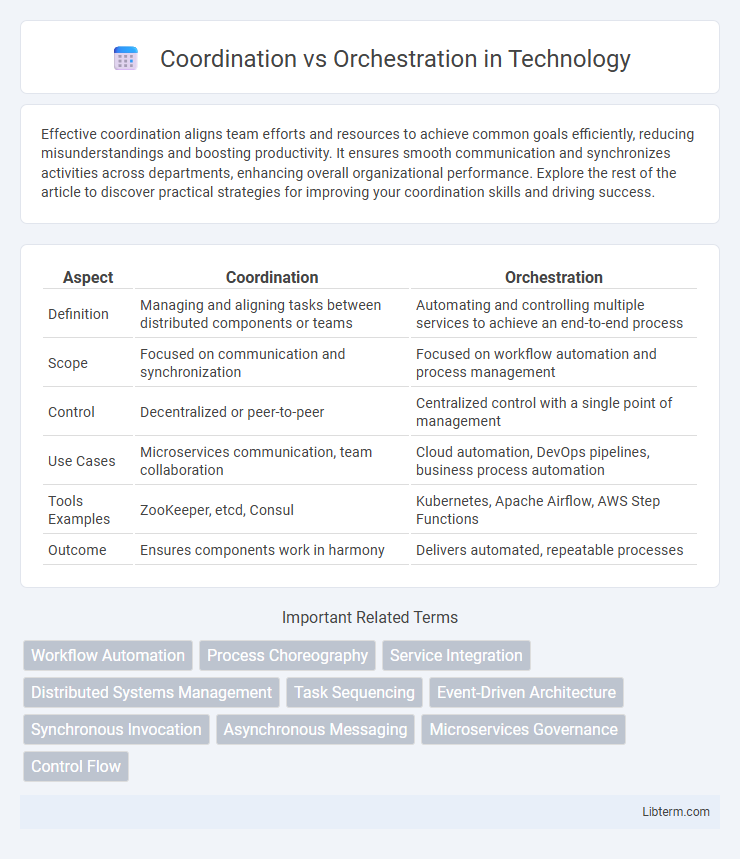Effective coordination aligns team efforts and resources to achieve common goals efficiently, reducing misunderstandings and boosting productivity. It ensures smooth communication and synchronizes activities across departments, enhancing overall organizational performance. Explore the rest of the article to discover practical strategies for improving your coordination skills and driving success.
Table of Comparison
| Aspect | Coordination | Orchestration |
|---|---|---|
| Definition | Managing and aligning tasks between distributed components or teams | Automating and controlling multiple services to achieve an end-to-end process |
| Scope | Focused on communication and synchronization | Focused on workflow automation and process management |
| Control | Decentralized or peer-to-peer | Centralized control with a single point of management |
| Use Cases | Microservices communication, team collaboration | Cloud automation, DevOps pipelines, business process automation |
| Tools Examples | ZooKeeper, etcd, Consul | Kubernetes, Apache Airflow, AWS Step Functions |
| Outcome | Ensures components work in harmony | Delivers automated, repeatable processes |
Introduction to Coordination and Orchestration
Coordination involves managing interactions between multiple components or services to ensure they work harmoniously towards a common goal, often emphasizing communication and synchronization. Orchestration refers to the automated arrangement, coordination, and management of complex workflows or service lifecycles, enabling efficient execution of business processes. Understanding the distinction between coordination and orchestration is essential for designing scalable and maintainable distributed systems.
Defining Coordination
Coordination refers to the systematic organization of interdependent tasks and resources to achieve a common objective, ensuring that efforts are harmonized without central control. It emphasizes collaboration, communication, and synchronization among various participants or systems to avoid conflicts and redundancies. Effective coordination optimizes workflow efficiency by aligning activities and facilitating information exchange within decentralized environments.
Understanding Orchestration
Orchestration involves the automated arrangement, coordination, and management of complex workflows and services to achieve a specific business goal. It integrates multiple systems and processes, ensuring seamless communication and synchronization between components in real time. Understanding orchestration is crucial for optimizing resource allocation and improving operational efficiency within IT and cloud environments.
Key Differences Between Coordination and Orchestration
Coordination involves managing interdependent tasks by aligning resources and schedules to achieve a common goal, often emphasizing communication and synchronization among participants. Orchestration, on the other hand, refers to the automated arrangement, control, and management of complex workflows or processes, typically implemented through software or systems to optimize performance and scalability. The key difference lies in coordination's focus on human-driven interaction and collaboration, while orchestration emphasizes automated, system-driven execution and integration of multiple services or components.
Use Cases for Coordination
Coordination is ideal for workflows requiring dynamic interaction between multiple independent services, such as real-time data synchronization in supply chain management and collaborative workspaces. Use cases include event-driven architectures where decentralized components must communicate effectively without centralized control, enhancing flexibility and scalability. Coordination ensures smooth cooperation in scenarios like multi-agent systems and microservices environments, where tasks depend on asynchronous messaging and shared state consistency.
Use Cases for Orchestration
Orchestration is essential in complex cloud environments where automated workflows coordinate multiple microservices, enhancing efficiency in continuous integration and delivery pipelines. It is widely used in Kubernetes to manage container lifecycles, ensuring scalability and fault tolerance through automated deployment and rolling updates. Orchestration also enables seamless integration of disparate systems in hybrid cloud environments, optimizing resource allocation and reducing manual intervention.
Benefits of Coordination
Coordination enhances efficiency by enabling seamless communication and collaboration among distributed teams and systems, reducing redundancies and errors. It fosters agility in dynamic environments by aligning resources and processes toward common goals, improving responsiveness to changes. Coordination also supports scalability, allowing complex projects to be managed more effectively through clear role definitions and synchronized activities.
Advantages of Orchestration
Orchestration offers centralized control over complex processes, enabling seamless integration of diverse systems and automated workflows that reduce manual intervention. It enhances scalability and flexibility by dynamically managing resources and adjusting operations in real-time according to changing demands. Improved visibility and monitoring capabilities support proactive issue resolution, leading to increased efficiency and reduced operational costs.
Coordination vs Orchestration: Which to Choose?
Coordination involves managing multiple independent services or components to work together harmoniously, emphasizing communication and synchronization without centralized control. Orchestration defines a centralized control mechanism that automates and sequences workflows, often used in complex IT environments like cloud computing and microservices. Choosing between coordination and orchestration depends on the system's complexity, scalability needs, and the level of automation required, with orchestration suited for structured, automated processes and coordination ideal for flexible, loosely coupled interactions.
Future Trends in Coordination and Orchestration
Future trends in coordination and orchestration emphasize increased automation and AI-driven decision-making to enhance efficiency in distributed systems. Emerging technologies like edge computing and blockchain are driving decentralized orchestration frameworks, enabling real-time, scalable service management across heterogeneous environments. Integration of machine learning models optimizes resource allocation and fault tolerance, accelerating the evolution of adaptive, intelligent coordination mechanisms in complex workflows.
Coordination Infographic

 libterm.com
libterm.com